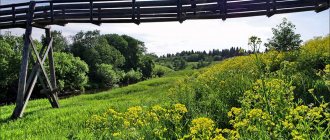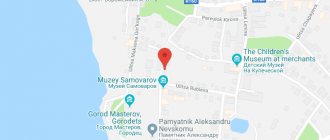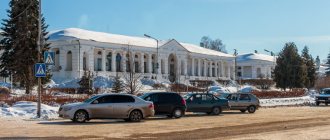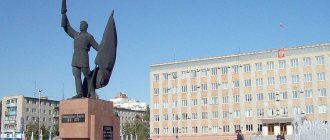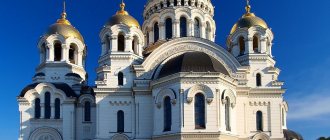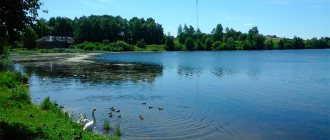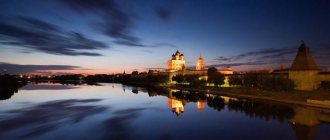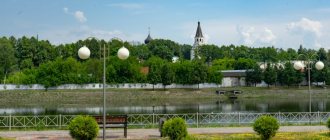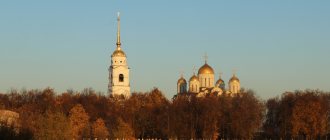City of Pskov (Russia)
Pskov is one of the oldest cities in Russia and the center of the region of the same name. It was founded at the beginning of the 10th century and is famous for a whole scattering of Russian medieval monuments of history, culture and architecture from the 12th to 17th centuries. Pskov is a city with many magnificent ancient churches and an impressive fortress with mighty walls and towers, in the structure of which its core stands out - Krom or the Kremlin. This is a place with an amazing (for our country) concentration of ancient attractions, which “breathes” tranquility and thousands of years of history.
The merchant is filthy
Pskov residents talk about one poor man who was engaged in making barrels and suddenly became rich. According to one version, in the corner of his modest shack he managed to find a treasure trove with countless treasures. True, in Rus' they did not approve of this method of obtaining wealth and called it filthy. So the name Pogankin stuck to the man, and his descendants became merchants. One of them, Sergei Pogankin , built chambers in Pskov in the 17th century; they began to be called Pogankin chambers.
There is another legend about the origin of the surname. One day, Tsar Ivan the Terrible came to Pskov, plundered it along with his army and demanded more money from the merchants. Then one of them asked how long the sovereign needed to calm down. The Terrible became angry and exclaimed: “Oh, you filthy one! Are you really so rich that you can give as much as I want?!” The merchant, understandably, was frightened and ran away, but the royal servants found him and brought him to bow to Ivan the Terrible. For some reason, the impudent Pskovite remained alive, but from then on they began to call him Pogankin.
The third (there are about five in total) Pskov legend says that a certain rich merchant did business with foreigners, who in those days were called “bastards”. So the merchant was nicknamed Pogankin.
Today, in the stone chambers of the merchant Pogankin, there is a museum with ancient utensils and items from treasures found in the city and its environs.
Might be interesting:
Saint Petersburg
Moscow
Velikiy Novgorod
Krasnodar
all cities
Geography and climate
Pskov is located in northwestern Russia near the border with Estonia and Latvia. The city lies on the lowland of the same name on the Velikaya River, where the Pskova River flows into it. Pskov Lake is 16 km away.
Pskov has a transitional climate from maritime to temperate continental. Summer here is relatively warm and quite rainy. Winter is cool, with usually persistent light frosts, which can be replaced by thaws.
Ancient Krom - the oldest part of Pskov
View of the pedestrian bridge over Pskovaya and Verkhne-Beregovaya street
The crossing across Pskova has existed in this place since ancient times. The pedestrian bridge is mentioned in documents from the 16th century. In the 19th-20th centuries, a wooden bridge on trestles was erected every spring from the Geldt Bath to the Epiphany Descent (next to the Church of the Epiphany from Zapskovye). Next to the temple (pictured on the right) there was a large household of the provincial architect Iosophat Danishevsky.
“The place is very beautiful. I live in Zapskovye, so I come here all the time. Everything pleases the eye, especially when it’s green. The bridge, of course, needs to be reconstructed, the fences changed, and lighting added. In general, there are problems with lighting in the city - I would like it to be brighter. There is a ramp at the bridge, but there is still a trodden path nearby. Here you need to think about functionality. They also screwed up the bike path: sometimes it’s unclear where pedestrians walk and where bicycles roll. We need to understand what to do with the Geldt Bath, and, accordingly, with the space nearby. Now it looks empty.”
Olga Mashkarina
Story
The exact age of Pskov is unknown. The founding date of the city is considered to be 903 - its first mention in the chronicles. The city grew and developed around a powerful fortress built on a steep hill at the confluence of the Pskov and Velikaya rivers. There are no analogues to this ancient fortification structure on the territory of modern Russia.
The construction of the Pskov fortress began in the 10th century. Most likely, its oldest part is the hill between the rivers (present-day Krom). The last major reconstruction of the fortress was undertaken by Peter I. The latest part of its structure is the Okolny town, built in the 16th century. Although its territory was inhabited much earlier (from about the 12th century).
For most of the Middle Ages (until the 17th century), Pskov was one of the most important and largest Russian cities. From the 10th to the 12th centuries it was subordinate to Kyiv. From the 12th century to the mid-14th century, Pskov was part of the Novgorod Republic, while having broad autonomy.
The first stone buildings appeared in Pskov around the 12th century. The heyday of Pskov architecture is considered to be the period from the 14th to the 16th centuries.
Pskov
In 1348, Pskov gained independence from Novgorod. At the same time, the Pskov Republic was formed, which existed until 1510. Although in fact, since 1399, Pskov has become dependent on Moscow. The period from the 14th to the 15th centuries is considered the heyday of the city. Most of its ancient temples were built at this time.
In 1510, Pskov was included in the Moscow Principality. At the end of the 16th century, the city was besieged by the Poles, but was never captured. Throughout the existence of the Russian Empire, Pskov remained an important city in the north-west of European Russia. In 1918 it was briefly occupied by German troops. In the early Soviet period, Pskov became a city of regional significance. During the Great Patriotic War it was occupied by Wehrmacht troops, which caused its serious destruction. In 1944, the Pskov region was formed, and Pskov became its center.
After the collapse of the USSR, throughout modern Russian history, Pskov was seriously neglected. Recently, there has been a tendency for its development and transformation of the city into a tourist center. But for now, a lot needs to be done in this direction. Therefore, you can still see a sad picture of dilapidated ancient buildings in ancient Pskov. But, we hope, their reconstruction is already close.
Elga under the drizzle
Pskovites are very creative. And they did everything in their own way, not like others. And they built in their own way, and governed the city, and painted icons in their own traditions. They even talked in their own way. In Russian, of course, but with peculiarities. For example, we now say: “I’ll go pick some mushrooms.” And in Pskov they would say: “I’ll go to the mushrooms.” It's like visiting. The Pskovites also had some unusual words: not soup, but pottage; not spruce, but spruce; not a light rain, but a drizzle.
And also - the freedom-loving people of Pskov, did not bow their heads to anyone. And even if in front of them was a noble boyar, even a rich merchant, they would not take off their hats. Because of this custom, residents of other cities believed that the Pskovites were too self-important. But they objected: “We take off our hats only to the saints.” This meant - in the temple, in front of the holy icons.
How to get there
Pskov has a small regional airport with several weekly flights to Moscow and St. Petersburg. The best way to get to Pskov is to fly to St. Petersburg and then take a high-speed train or bus. Trains from Moscow are very slow. It's better to choose a bus. Pskov has regular bus service with Moscow, St. Petersburg, Veliky Novgorod, Vitebsk, Tallinn, Riga and Tartu.
Walls of the Pskov Kremlin
Your own mint
Pskov is such a unique Russian city that it even had its own money. The Pskov Mint (money) court issued its own coins from 1425 to 1510, and then, until its closure in 1632, minted money for the entire Russian state, together with the Moscow and Novgorod courts.
The coins of Pskov, like the coins of Novgorod, were divided into “dengi” (“Pskovka”) and “chetverettsy”, which formed part of them. On Pskov money, on the obverse side, an image of Prince Dovmont , who ruled Pskov from 1266 to 1299, was minted, wearing a crown and holding a sword. On the reverse side one could see the inscription “Pskov denga”, or a four-legged animal, presumably a leopard, turned to the right or left, framed by a similar inscription.
The design of Pskov coins was different from those minted in other cities - the “Pskov coins” were clearer, more standardized, which is typical of the European-Western type.
The minting of coins indicates the maturity of the subject in the international arena. Pskov conducted active trade with the cities of the Hanseatic League, as evidenced by archaeological finds, including from the Mstislavsky excavation site, where Western European lead trade seals were found.
Before the appearance of the mint in Pskov, foreign coins were used, and in some cases, lead seals with a princely sign and an image of a saint were used to seal documents for small transactions or orders. Because they were no longer needed, they were sometimes thrown away, and local residents exchanged small lead pieces for bread, which clearly was not worth a whole silver coin. Also, money was replaced by wiped squirrel skins.
In the 16th century, the population of the city then exceeded 30 thousand people, most of whom were artisans and traders. In the city there were many blacksmiths, masons, tanners, potters, jewelers and merchants who traded with Russian cities, the Baltic states and Lithuania. Pskov residents sold flax, leather, fish, honey, wax, furs, and bought salt, cloth, iron, and metal products.
Attractions
Pskov has a huge number of interesting sights, among which the ancient Krom (Kremlin), as well as several dozen ancient temples and chambers, stand out.
The main attractions of Pskov
Pskov Fortress
Pskov Fortress is the most famous landmark of the city. This is the most powerful and beautiful fortification structure of the period of Ancient Rus', in the structure of which stone walls and towers are well preserved, as well as other attributes of outposts: ramparts, ditches and underground passages. The Pskov fortress had several defensive lines and included: Krom (the core of the fortress and its most protected part), Dovmontov city, the wall of the mayor Boris and the Middle city.
Once the length of the walls of the Pskov fortress was about 9 km. The fortress was built over five and a half centuries. Moreover, throughout its eight-century history it has never been taken by storm. The material for the construction of the walls was a limestone slab. The slabs were held together with lime mortar. The fortress included five defensive rings, being one of the most advanced medieval outposts in all of Europe.
Chrome
Pskovsky Krom
Krom is the oldest and most important part of the Pskov fortress, built on a high hill. Its western wall stretches along the bed of the Velikaya River, and its eastern wall stretches along the bed of the Pskov River. The chrome has the shape of a triangle. It is protected by four ancient towers: Smerdya (Dovmontova), Kutekroma (Kutnyaya), Srednyaya (Snetnaya) and Troitskaya (Chasovaya). In the Middle Ages, one could get to Crom through two gates. Only the Trinity Gate has survived to this day.
The exact date of the founding of Krom is unknown. Archaeological research indicates that the first stone walls were built here already in the 10th - 12th centuries. Krom acquired its modern appearance in the 13th - 14th centuries. The towers (except for the ancient Smerdya, built in the first half of the 14th century) were built throughout the 15th century.
The architectural dominant feature of Pskov is the imposing Trinity Cathedral, built in the 17th century in the style of traditional Russian architecture. This temple rises above the vast space of the ancient square where the Pskov veche took place.
Krom's scheme
Dovmontov city
Dovmontov city adjoins Krom on the south side. This area of Pskov was founded in the second half of the 13th century by the Lithuanian prince of the same name. Before this, artisans lived here. Also in ancient times, there was a market square on this territory - Torg. In the 14th - 15th centuries, Dovmontov city was the administrative and religious center of Pskov. At that time, there were more than 15 churches on its territory, as well as many civil buildings.
Order chambers
Now Dovmontov city lies in ruins. Here you can only look at the foundations of ancient temples. The only well-preserved buildings in this quarter are the Order Chambers, built at the end of the 17th century. This building now houses a museum.
Wall of Posadnik Boris
The wall of Posadnik Boris (area of Profsoyuznaya Street) was founded at the beginning of the 14th century to protect Krom from the south. In the 15th century it was dismantled so as not to interfere with the growth of the city. In ancient times this site had ten towers. Only one has reached our time - Mstislavskaya.
The area between the wall and the river was a swamp in ancient times. For centuries, the inhabitants of Pskov filled up the swamp. Under mayor Boris, this place was paved with wood and used for market purposes. Over time, the swamp was completely filled up.
Chrome
Medium city
The middle city is the territory between Dovmontov city and Okolny. This area was once called Zastenje, as it was located outside the 14th century walls. In the 16th century, the Okolny Town was built, and Zastenye began to be called the Middle Town, located between two lines of walls.
Now the border between Sredniy Gorod and Okolny has been erased.
In the late Middle Ages, this area was characterized by very dense buildings. At that time, there were more than 6 thousand courtyards and dozens of temples, many of which have survived to this day.
Okolny town
The Okolny town is the latest part of the Pskov fortress, completed in the 16th century. It is fortified with powerful walls up to 5 meters thick, which have withstood several serious sieges.
The walls of the Okolny City were 3 km long. They once included seven towers. Only three of them have survived to this day.
Beautiful towers of the Pskov fortress
Flat Tower
The Flat Tower dates back to the 14th century. Despite some squatness, which is why it got its name, this is one of the most expressive towers of the Pskov fortress. This structure has a purely defensive purpose and is reinforced with loopholes.
The flat tower forms one of the most famous views of Pskov. This is a very photogenic place.
Mstislavskaya Tower
Mstislavskaya Tower is the only surviving part of the fortifications of the Middle City, which, apparently, was previously part of the wall of the mayor Boris. The tower was built in the 14th century. It has an outer diameter of 15 m and a wall thickness of up to 2.5 m.
Pokrovskaya Tower
The Pokrovskaya Tower is one of the most beautiful and probably the most powerful tower of the Pskov Fortress. It is considered the largest fortress tower in Europe, having an outer diameter of 90 meters. Once this structure had five tiers. The thickness of the tower walls ranges from 6 meters to 3.5 meters. This structure was built in the late 15th and early 16th centuries. The foundation for the tower is a rock foundation.
Vlasyevskaya Tower
The Vlasyevskaya Tower is a powerful 32-meter tower, built in the 16th century and guarding the only passage gate to ancient Pskov.
Temples of Pskov
Pskov is famous for its magnificent sacred architecture. Here you can see several dozen medieval stone churches, which are unique monuments of ancient Russian architecture.
Holy Trinity Cathedral
The Holy Trinity Cathedral is the main temple of Pskov, located in Krome on the former veche square. According to legend, the first church here was founded in the 10th century by Princess Olga. The current temple is the fourth and dates back to the second half of the 17th century.
The Holy Trinity Cathedral was built in the style of traditional Russian architecture. This is the tallest building in the ancient city (78 m). Inside, the cathedral has simple white walls, among which an impressive iconostasis stands out. Nearby is a 17th century bell tower built on the foundation of a fortress tower.
Church of Kozma and Damian from Gremyachaya Mountain
The former Gremyatsky Monastery is an ancient monastery, abolished at the end of the 18th century. A medieval stone church from the 14th century, rebuilt in the 16th century after a fire, has survived to this day.
Temple of Alexander Nevsky
The Alexander Nevsky Temple is a beautiful brick church built in the early 20th century.
Church of the Resurrection of Christ
The Church of the Resurrection of Christ is an ancient church founded in the 16th century. It is an active temple.
Church of Peter and Paul from Buya
The Church of Peter and Paul from Buya is an ancient Orthodox church, first mentioned in the 14th century. The current church was built in the first half of the 16th century. The building has a structure typical of Pskov churches - one dome, three apses and a simple white facade.
Church of St. Sergius of Radonezh from Zaluzhye
The Church of St. Sergius of Radonezh from Zaluzhye is considered one of the most elegant sacred monuments of Pskov. The temple was founded in the Middle Ages and was once part of the monastery of the same name. The church was rebuilt several times over the 17th and 18th centuries. An interesting feature of the building is the beautiful dome with ceramic coating.
Church of St. Varlaam Khutynsky
The Church of St. Varlaam of Khutyn is an ancient medieval temple built at the end of the 15th century.
Church of St. John the Evangelist
The Church of St. John the Evangelist is an ancient temple in the style of ancient Pskov architecture. The exact date of construction of this monument is unknown. According to some sources, the church dates back to the 14th century, and according to others, to the 15th or 16th century.
Church of the Intercession and Nativity of the Virgin Mary
The Church of the Intercession and Nativity of the Virgin is an ancient temple, first mentioned in 1399. Located in the southwestern part of the Okolny town near the Pokrovskaya tower.
Old Ascension Church
The Old Ascension Church was built in the first half of the 16th century on the site of an older religious building. In ancient times, there was a convent on this site.
Church of the New Ascension
The New Ascension Church was part of the Novo-Voznesensky Monastery, abolished by Catherine II in the 18th century. The exact age of the church is unknown. The building may date back to either the 14th century or the 16th century.
Church of the Epiphany
The Church of the Epiphany is an ancient church located at the ancient ford across the Pskova River. It was founded at the end of the 14th century. The existing church dates back to the 15th century and is one of the main churches in the Zapskov region.
Church of St. Nicholas the Wonderworker
The Church of St. Nicholas the Wonderworker is a magnificent monument of sacred architecture of ancient Pskov and one of the most important Pskov churches. The church was first mentioned in 1371. The current building dates from the first half of the 16th century.
Church of St. George from Vzvoz
Church of St. George from Vzvoz is a stone church built in 1494.
Church of the Assumption of the Blessed Virgin Mary
The Church of the Assumption of the Blessed Virgin Mary is an interesting ancient church, first mentioned in 1444. The current building dates from the first half of the 16th century. The church was built near an ancient ferry crossing.
Mirozhsky Monastery
Mirozhsky Monastery is one of the oldest Russian monasteries, founded in the 12th century. It was closed during the Soviet period and restored quite recently.
The monastery includes several religious buildings: the Cathedral of the Transfiguration of the Savior - one of the oldest churches in Pskov, founded in the 12th century, with frescoes from the pre-Mongol period, Stephen's Church of the 17th century and the bell tower of the 19th century.
Cathedral of the Nativity of John the Baptist
The Cathedral of the Nativity of John the Baptist is one of the oldest (among the surviving) ancient Russian churches. The church was first mentioned back in 1243 (even before the Tatar-Mongol invasion). The temple combines features of Novgorod and Byzantine architecture.
Church of St. Basil on Gorka
Church of Vasily on Gorka is a beautiful Pskov temple, built between 1413-1415.
Church of the Great Martyr Barbara
The Church of the Great Martyr Barbara is a wooden church that dates back to 1618.
Church of the Archangel Michael and Gabriel
The Church of the Archangels Michael and Gabriel is an ancient Orthodox church built in the 14th century. Located on the old shopping square, which was one of the centers of ancient Pskov.
Other sights of Pskov
Golden embankment
Golden embankment is one of the most beautiful places in Pskov. To the left is Crom and to the right are beautiful old houses from the late 19th and early 20th centuries.
Pogankin chambers
Pogankin Chambers is one of the most beautiful examples of civil construction in Pskov. This stone building was built in the 17th century. Now the main exhibitions of the local museum are located here, including unique ancient icons.
Monument in memory of the Battle of the Ice
The monument in memory of the Battle of the Ice on Lake Peipus is one of the most beautiful and interesting sculptural compositions in the city. It was installed in 1993. It is believed that the route of Alexander Nevsky’s troops to battle passed here.
Church-fortress
The churches in Pskov are unusual - narrow windows, thick walls and in each church there are pantries for provisions. And here's the thing. When the enemy approached the city, men and women armed themselves and, if they could not hold the city wall, went to the temple. And every temple became a fortress. And there were many churches in the city, they were all made of stone, thick, and could withstand a long siege, because inside they had supplies for the besieged, both water and food.
The strength of spirit and Christian faith of the Pskovites could work miracles. Once upon a time, the Polish king Batory besieged Pskov. When he approached its walls, he said in admiration: “Besides Paris, I have not seen anything similar in size and beauty. May God grant us to take this city." The inhabitants of Pskov bravely defended themselves, but finally their last strength was exhausted. And then they decided to organize a religious procession with the icon of the Mother of God along the street that led to the city wall, which was attacked by enemies with particular fury. They did not know that the Poles secretly dug an underground passage to this wall and laid gunpowder under it. At that very moment, when the religious procession almost reached the wall itself, a terrible explosion was heard, the wall was swept away, and Polish soldiers burst into the city screaming. But they did not encounter soldiers, but a procession of the cross, in front of which they carried an icon of the Mother of God. And suddenly they saw that it was not an icon, but the Mother of God herself appeared before them and demanded that they get away from the city. And although the forces were unequal, the Poles turned around and ran away in panic. They did not storm Pskov again. They tried to starve the city out, but they refused to storm it, saying that the Mother of God did not order them to do so.
Might be interesting:
Sochi
Kazan
Smolensk
Kaliningrad
all cities
